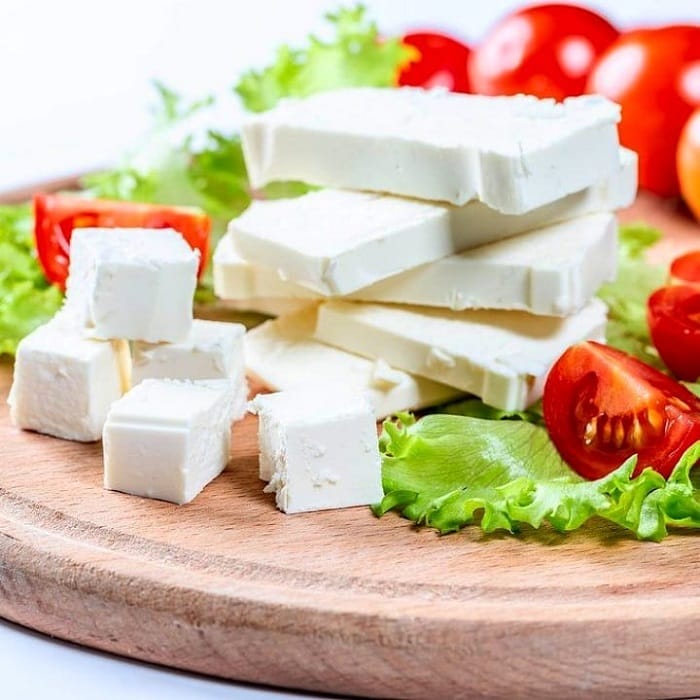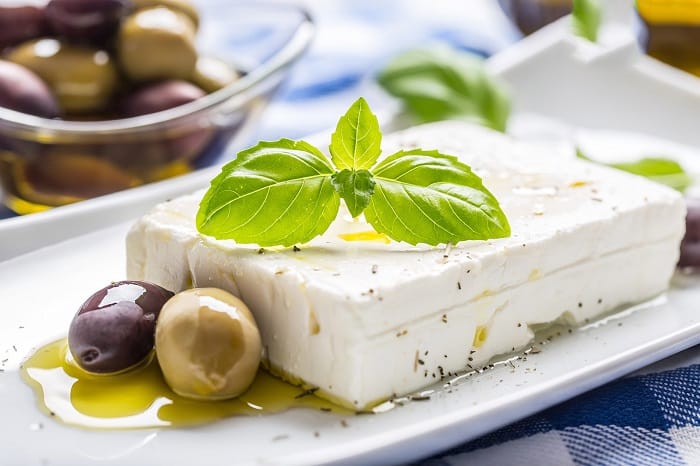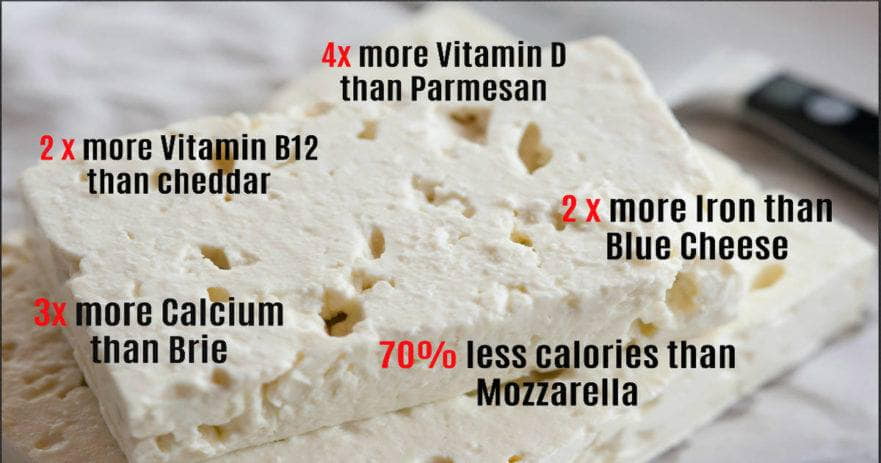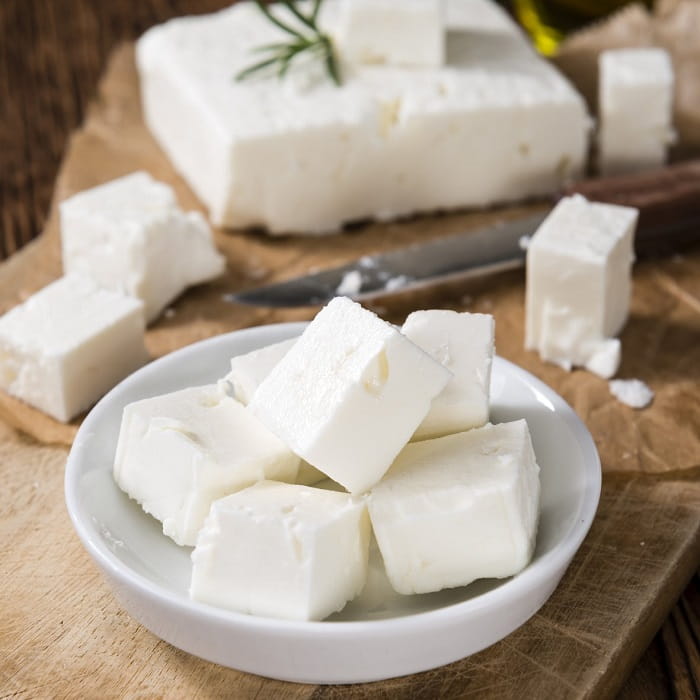So, you’ve heard about Feta cheese. But do you know what it tastes like? Does Feta Cheese melt? How do you melt it? Let’s talk about these questions in this article. Hopefully, you will gain a new appreciation for feta cheese. After all, it’s one of the most popular cheeses in the world.
About Feta Cheese

Do you love cheese? Do you love the taste of fresh, creamy cheese? If so, then you’ll love feta cheese!
Feta cheese is a type of cheese that is made from sheep’s milk. It is a soft cheese with a strong, salty flavor. Feta cheese is a staple in Greek cuisine and is often used in salads and pies.
Feta cheese is a healthy cheese, and it is low in calories. It is also a good source of protein and calcium.
What does feta cheese taste like?
If you want a delicious addition to a salad, try feta cheese. It has an intense taste and is packed with B vitamins and calcium. It can be eaten alone or mixed with a fresh salad. It also works well on sandwiches, pasta, and in greek yogurt.
Feta cheese is a brine-cured cheese with a tangy, salty, buttery flavor. Its flavor varies depending on its region of origin, how long it has been aged, and how it is served. It is often considered one of the best cheeses in the world, and it packs more beneficial nutrients than other types.
Feta can come in blocks, crumbles, and other forms. Blocks are the most popular, as they are cheaper and easier to crumble. Crumbles, on the other hand, tend to be crumbly and contain anti-caking agents.
Does Feta Cheese Melt?
No, feta cheese does not melt even if it is crumbled. When heated, it will only soften. The same goes for other cheeses like mozzarella, cheddar, and gouda. So, if you’re looking for a cheesy dish oozing with melted cheese, you’ll have to look elsewhere.
Why Feta Cheese Doesn’t Melt

When looking for an alternative cheese for your next cheeseboard, you might find that Feta cheese isn’t a good fit. This cheese has a high acid content so it won’t melt completely. However, it will soften slightly when heated and can be a good match for grilled kabobs. Alternatively, you might want to consider other kinds of cheeses, such as paneer or queso fresco.
If you’re worried that feta cheese won’t melt, here are some helpful tips: Use a double broiler, microwave, or double broiler to melt it. You should also remember that feta will disintegrate more than melt, so it’s essential to watch out for burning and other problems.
Another reason feta cheese doesn’t melt is its high water and acid content. Its unique flavor results from this high acidity level and high water content.
Benefits of non-melting feta cheese
When heated, feta cheese will not melt. Unlike other types of cheese, feta will not liquefy so you can enjoy its creamy flavor and texture. Non-melting feta is also great for making warm cheese dips. While you can’t force this type of cheese to melt, there are ways to make it more pliable. One way is to add lemon juice, milk, or white wine. While these methods are not foolproof, they can help to overcome the calcium conflict and bring some moisture to the cheese.
Grilled feta cheese is a great way to add a healthy protein snack to your diet. Aside from being low in fat, non-melting feta cheese is also rich in essential vitamins and minerals. These nutrients support digestive health and can help prevent chronic diseases. It can also help manage blood sugar levels.
Non-melting feta cheese also helps improve the texture and taste of salads and other dishes. Its low-carbohydrate content means that it won’t add unwanted weight. As a result, it is an excellent alternative to regular hard cheese.
Can You Heat Feta Cheese?

It is possible to melt feta cheese in the microwave, but it’s important to remember to bring it to room temperature first. When using a large block, ensure it is broken into small pieces before heating. You should also wait at least 15 minutes before microwave cooking.
You can use feta cheese in a variety of dishes. It’s great crumbled over salads tossed with roasted vegetables or grains or served on flatbread. It’s also good on grilled kabobs. Its high acidity and moisture level help keep it from liquefying.
Because feta doesn’t melt when on its own, you can use it in warm cheese dips. It’ll melt faster when it’s at room temperature, but you shouldn’t heat it above room temperature because it can become a breeding ground for harmful bacteria.
What does feta do when heated?
When heated, feta cheese melts but does not turn liquid. This is due to the high acid content. The acid dissolves the cheese’s calcium, which makes it melt. It will not become stringy or liquid, but the texture will change. It will also become soft.
This characteristic of feta cheese helps it keep its shape when heated. It is not as soft as you might think. When heated, other types of cheeses melt, making them stringy. However, feta cheese retains its shape and does not become stringy. The high acid content also prevents it from becoming stringy when heated.
One common misconception about feta cheese is that it melts when heated. However, this is not entirely true. The heat necessary to melt feta cheese depends on how it’s heated. When heated, feta cheese softens slightly but does not melt completely.
How to make feta melt
When making a feta cheese melt, it is important to use quality feta cheese. You should purchase the thick, creamy variety made in Greece, which is not crumbled. Crumbled feta will not melt well in this recipe and will remain chunky. You can also use French or Bulgarian white cheese if you don’t have access to Greek feta. You should also purchase good quality olive oil for this dish, as it will add richness and flavor.
While feta is usually used for savory dishes, it can also be used in different words. In addition to being great in salads and soups, it can also be used in sandwiches and baked cheese balls. It will keep its shape when appropriately heated, unlike other kinds of cheese that might liquefy.
Because feta is not a soft cheese, it may take some time to melt completely. It is best to let it reach room temperature before attempting to melt it in a microwave. You can also add milk to the mixture before putting it into the microwave to speed up the melting process.
Can You Melt Feta Cheese In The Microwave
You may be wondering if you can melt Feta cheese in the microwave. It is one of the most common ingredients in Mediterranean cuisine and is often used in various recipes. Because of its high moisture content, it melts very quickly over medium heat. It is best to break up the pieces of cheese into smaller pieces before heating them. This will allow the cheese to become softer and easier to work with. It is also essential to keep the cheese at room temperature for at least 20 minutes before heating it.
Melting cheese in the microwave is easy and convenient if you use the right ingredients. Shredded cheese is the easiest to melt in the microwave. Heat the cheese for a minute on 50% of the medium. Make sure to stir the cheese so that it melts evenly. Once the cheese reaches 130 degrees Fahrenheit, it is ready to be used. Softened feta cheese is another good candidate for the microwave, as long as you follow the correct instructions for the type of cheese.
See:
Can Feta Cheese Melt In The Oven?
When baking feta cheese, it’s best to purchase a high-quality variety that is brined. This brine adds flavor and improves the texture. If you cannot find Greek feta, you can substitute another white cheese, such as French or Bulgarian. You can use crumbled feta if you don’t want to use fresh cheese. Crumbled feta, on the other hand, is too dry and won’t soften enough once baked.
When it comes to preparing feta cheese, it’s important to remember that this cheese contains 19% acid. This acid is called pantothenic acid, giving feta cheese its characteristic tang. This acid also has a high melting point.
Other Methods To Melt Crumbled Feta Cheese
There are a variety of methods available for melting crumbled feta cheese. A simple process is baking the cheese, which is a great way to soften a hard cheese. This method will produce a soft texture and a creamy top. It should be placed in an oven-proof dish for a few hours.
Another method for melting crumbled feta is adding a little whole milk. This will help soften the cheese but will keep its shape. You can also place the cheese in the microwave to melt. This will cause it to liquefy and form a sauce.
Is Feta Cheese Healthy?

Feta cheese is made from sheep or goat milk, which makes it rich in saturated fat and sodium. However, it does contain some vitamins and minerals. As a result, it does have some nutritional value. However, the amount of sodium in feta cheese is higher than in other cheeses, so it should be used in moderation.
Feta cheese contains a probiotic called Lactobacillus Plantarum, which has several health benefits. These include boosting your immune system and improving digestive health. It can also help reduce the symptoms of lactose intolerance. It also contains histidine, which is a compound that has anti-inflammatory effects. It is a source of vitamin B6 and Vitamin B12.
Feta cheese is high in calcium and protein, and a moderate amount is good for your health. Although it contains high levels of saturated fat and sodium, it is still a good choice for most people. It is also rich in B vitamins that support the nervous system, the skin, and energy production. While feta is a good source of essential vitamins, it is still important to limit your consumption because of the high amount of sodium.
What is healthier, feta or mozzarella?
The two kinds of cheese can be substituted for each other. While mozzarella is milder and lower in sodium, feta contains more calcium. In addition, mozzarella includes probiotics, which can help reduce inflammation in the body. Feta cheese is traditionally made from sheep or goat milk and is higher in phosphorus, which is good for teeth and bones.
These cheeses contain similar amounts of vitamin E. However, feta has higher amounts of riboflavin, niacin, and folate than mozzarella. Both kinds of cheese are high in calcium, so they are good choices for salads. While mozzarella is better for you in terms of calcium content, feta is better for your overall health.
If you’re concerned about calories, try a low-fat version. This cheese is lower in fat than mozzarella, but you should still limit your portion to one ounce. This type of cheese has less fat and sodium and is more likely to lower your cholesterol level. However, if you’re unsure which cheese is better for you, consider choosing part-skim mozzarella. This type of cheese is also lower in saturated fat and sodium.
Does feta melt on pizza?

If you’re wondering, “Does feta cheese melt on pizza?” there are several ways to make it happen. For one thing, feta cheese has a higher acid content than other cheeses, so it does soften up a bit. It also melts more easily on certain foods, like grilled kabobs.
Another way to get feta cheese to melt on your pizza is to mix it with a bit of whole milk. Do this over a double broiler, or use a microwave. The liquids will help the feta cheese melt more quickly, but this will change the flavor of the feta cheese.
You can also make whipped feta cheese by combining all ingredients in a food processor. Once the mixture reaches a fluffy consistency, spread it over your pizza crust. Add sliced tomatoes, green or kalamata olives, and shredded mozzarella cheese to your pizza. If you prefer, you can sprinkle toasted pine nuts on top.
Is feta cheese good for weight loss?
There are several reasons why people should limit their feta cheese consumption. This cheese has a high sodium content, and too much can increase the risk of high blood pressure and kidney problems. It is also very high in calories and fat. This combination can lead to weight gain. Furthermore, people who are lactose intolerant should avoid feta cheese. This cheese is made from cow’s milk, so they should speak to their healthcare providers to see if it is safe to eat.
While feta cheese has some health benefits, it is not recommended for pregnant women or lactose intolerant people. It contains a bacteria known as Listeria monocytogenes, which can cause a bacterial infection called listeriosis. This bacteria also affect pregnant women, so it’s important to choose pasteurized cheese to avoid this problem.
Feta cheese is low in fat compared to other types of cheese. It also contains beneficial nutrients for the heart. Some studies have even shown that feta cheese can help reduce the risk of heart disease and hypertension. It also includes a variety of B vitamins, which support the nervous system and energy production. Moreover, it has a high calcium content, which helps maintain the health of the teeth.
FAQs
Does feta melt in a sauce?
The answer to this question is yes, feta cheese will melt in a sauce. However, it is essential to note that feta cheese will not melt as other cheeses will. This is because feta cheese is very crumbly. As a result, it will not create a smooth, creamy texture when melted. Instead, feta cheese will crumble and melt quickly.
This can be a good thing or a bad thing, depending on what you are looking for in your sauce. If you want a smooth, creamy sauce, you may want to consider using another type of cheese. However, feta cheese is a great option if you want a sauce with many flavors.
Can you melt feta in a pan?
The short answer is: maybe. Feta is a non-melting cheese, so it’s not ideal for melting. However, if you’re determined to melt feta, you can do so in a pan. Just be aware that the results won’t be as smooth or creamy as with other melting cheeses.
If you’re looking to add feta to a dish where melted cheese is desired, it’s best to crumble the feta and add it near the end of cooking. This will help to prevent the feta from becoming rubbery.
Is feta like mozzarella?
The answer may surprise you, but the two cheeses share quite a bit. For one, they’re both easy to melt and crumbly. This makes them ideal for dishes like pizza and lasagna, where you want the cheese to spread quickly and cover the food.
Another similarity between the two kinds of cheese is their flavor. Both feta and mozzarella have a slightly salty, tangy taste that pairs well with other ingredients. This makes them both versatile and popular choices for cooking.
Mozzarella is a fresh cheese that doesn’t have the tangy flavor of feta.
So, while feta and mozzarella may share some characteristics, they are two very different cheeses.
What cheese is healthier than feta?
Goat cheese is a type of cheese that is made from goat’s milk. Goat cheese is lower in calories and fat than other cheese types and is also a good source of protein. Goat cheese also contains less lactose than different cheeses, making it easier to digest for lactose-intolerant people.
In addition to being lower in calories and fat, goat cheese is also a good source of calcium and other minerals. Goat cheese has been shown to help reduce the risk of osteoporosis, and it can also help to lower blood pressure.
Does feta cheese go bad?

The first thing to remember is that feta cheese is a fresh cheese, which means it is not aged. This means feta cheese will not last as long as other types of cheese. However, if you store feta cheese in the refrigerator, it can last up to two months.
If you want your feta cheese to last even longer, you can freeze it. However, you will need to thaw the cheese before you use it, so it is best to use it within a month of freezing it.
When it comes to feta cheese, there are a few things you need to keep in mind to make sure it lasts. First, feta cheese is fresh, so it does not last as long as other types of cheese. Second, you need to store feta cheese in the refrigerator, and third, you can freeze feta cheese to make it last even longer.
Does blue cheese melt?
Yes! Blue cheese melts wholly and quickly, making it an excellent cheese for melting into sauces or onto pizzas.
So, why does blue cheese melt so well? It all depends on the milk that blue cheese is made from. Blue cheese is usually made from cow’s milk with high-fat content. This high-fat content helps the cheese to melt quickly and evenly.
Does feta cheese have lactose?
Feta cheese is made from sheep’s milk and has an average lactose content of 4.1%. This means that feta cheese is a good choice for lactose intolerant or looking for cheese with lower lactose content.
What is feta cheese made from?
Well, it’s made from 100% sheep’s milk or mixed in up to 30% goat’s milk. And that’s what gives it its unique flavor.
Feta cheese is an excellent addition to any meal. It’s perfect in salads, on pizzas, or just by itself. And it’s also a healthy cheese, as it’s lower in fat and calories than most other cheeses.
Conclusion
Unlike other cheeses, feta does not melt easily. While it may become soft and mushy when heated, it will not dissolve completely. This is due to its high acid content and water content. This makes it less suitable for melting applications. However, feta is still a good option if you plan to use it in cold recipes. Many salads and other dishes include this cheese.
Feta cheese has a unique flavor and is a staple in Eastern Mediterranean cuisines. It is made from sheep or goat milk. It is also available in many grocery stores and farmers’ markets. Feta is not as salty or creamy as other cheeses, and its texture changes with age.
Feta cheese can develop black spots or a pinkish-white color. These spots are signs of rancidity. Free radicals in the cheese react chemically to form ketones. The resulting smell is similar to nail polish remover. Furthermore, feta cheese ages faster than most other types of cheese. Hence, it is best to consume it before the expiration date.
- How Long To Bake Salmon At 425 in Foil? - December 11, 2022
- How Long To Cook Chuck Roast In Oven At 350? - December 11, 2022
- How Many Chicken Wings Are In A Pound? - November 26, 2022
